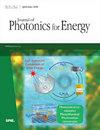Spheroid-based optical cavities for tunable photon recycling and emitter temperature control in robust solar thermophotovoltaic systems
IF 2.1
4区 工程技术
Q4 MATERIALS SCIENCE, MULTIDISCIPLINARY
引用次数: 0
Abstract
Abstract. The theoretical efficiency of solar thermophotovoltaic (STPV) systems is much greater than their efficiencies achieved in practice. Optical cavities can improve the performance of STPV systems by increasing the emitter-to-PV cell view factor and by facilitating photon recycling, whereby photons are reflected back to the emitter. Photon recycling reduces losses and increases the temperature of the emitter, thereby increasing efficiency. Our study presents STPV systems comprising optical cavities in the form of oblate and prolate spheroids. The geometry of the optical cavity can be tuned to control the degree of photon recycling, emitter temperature, emission losses, and the emitter-to-PV cell effective view factor and separation distance without using complex nano- or microstructured materials or optical filters. Numerical analysis shows an optical cavity in the form of a prolate spheroid, prolate spheroid with a middle annular aperture specular reflector, and integrated oblate- and prolate-spheroid can be used to achieve efficiencies of 17.7%, 18.9%, and 22%, respectively, under solar irradiation at a concentration factor of 1500X. These robust spheroid-based optical cavities can be used to design improved STPV systems with increased durability and higher performance.用于可调谐光子回收和鲁棒太阳能热光伏系统发射极温度控制的球形光学腔
摘要太阳能热光伏(STPV)系统的理论效率远大于其在实践中实现的效率。光学腔可以通过增加发射器到光伏电池的视角因子和促进光子回收来提高STPV系统的性能,从而将光子反射回发射器。光子回收减少了损失并提高了发射器的温度,从而提高了效率。我们的研究提出了STPV系统,包括扁球体和长球体形式的光学腔。在不使用复杂的纳米或微结构材料或滤光器的情况下,可以调整光学腔的几何形状以控制光子回收的程度、发射器温度、发射损耗以及发射器到PV电池的有效视角因子和分离距离。数值分析表明,在1500X的太阳辐射下,采用椭球体、带中间环形孔径镜面反射器的椭球体以及集成扁椭球体和椭球体形式的光学腔可以分别获得17.7%、18.9%和22%的效率。这些坚固的基于球体的光学腔可用于设计具有更高耐用性和更高性能的改进型STPV系统。
本文章由计算机程序翻译,如有差异,请以英文原文为准。
求助全文
约1分钟内获得全文
求助全文
来源期刊

Journal of Photonics for Energy
MATERIALS SCIENCE, MULTIDISCIPLINARY-OPTICS
CiteScore
3.20
自引率
5.90%
发文量
28
审稿时长
>12 weeks
期刊介绍:
The Journal of Photonics for Energy publishes peer-reviewed papers covering fundamental and applied research areas focused on the applications of photonics for renewable energy harvesting, conversion, storage, distribution, monitoring, consumption, and efficient usage.
 求助内容:
求助内容: 应助结果提醒方式:
应助结果提醒方式:


